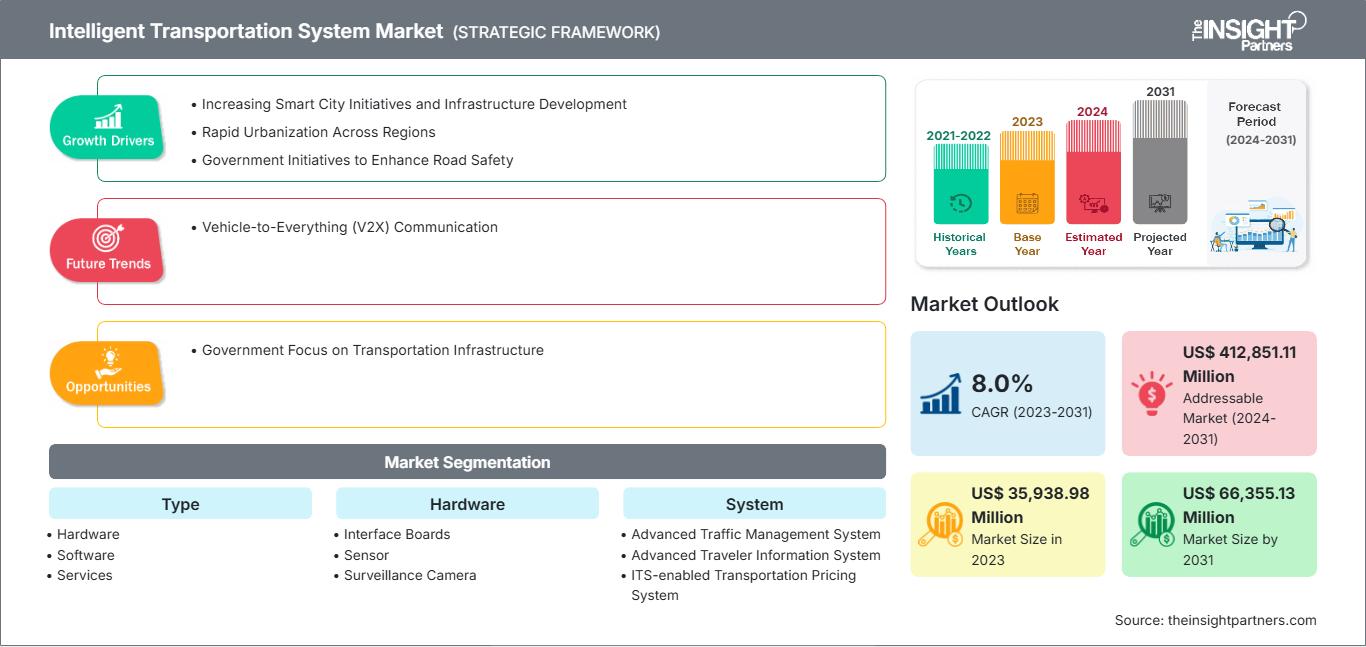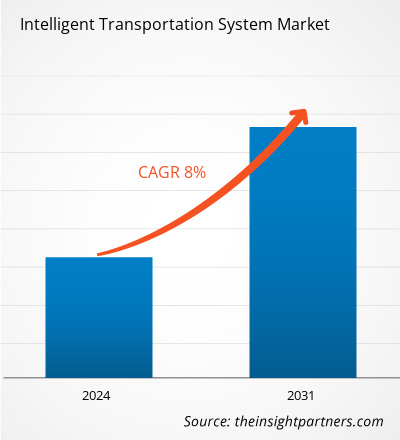Le marché des systèmes de transport intelligents devrait atteindre 66 355,13 millions de dollars américains d'ici 2031, contre 35 938,98 millions de dollars américains en 2023. Le marché devrait enregistrer un TCAC de 8,0 % entre 2023 et 2031. La mise en œuvre du V2X pour les systèmes de transport intelligents devrait émerger comme une nouvelle tendance au cours de la période de prévision.
Analyse du marché des systèmes de transport intelligents
Les routes (composantes essentielles des infrastructures urbaines) facilitent la mobilité humaine et la logistique, servent de base à la croissance sociale et économique et relient les villes, les ports et les aéroports. Bien que l'entretien et le développement des routes favorisent la croissance économique, l'augmentation du volume de trafic entraîne des problèmes tels que la surpopulation et les accidents de la route. Les conséquences négatives de l'augmentation du nombre de véhicules se sont aggravées ces dernières années. Elle a entraîné une augmentation significative des accidents de la route et une dégradation de l'environnement due aux émissions de gaz à effet de serre. Pour améliorer la gestion du trafic et les infrastructures, les STI utilisent un large éventail de TIC basées sur des connexions filaires et sans fil. Ils réduisent les risques liés au transport, désengorgent le trafic, augmentent l'efficacité des transports, diminuent la pollution et améliorent l'expérience de conduite, la sécurité et la capacité du réseau routier. En intégrant des technologies de communication de pointe aux infrastructures et aux véhicules de transport, les STI augmentent la productivité, améliorent la mobilité et la sécurité des transports, et renforcent les connexions mondiales. Ainsi, la demande en STI devrait croître dans les années à venir. Le marché des systèmes de transport intelligents (STI) est principalement stimulé par l'augmentation des initiatives de villes intelligentes et du développement des infrastructures, l'urbanisation rapide des régions et les initiatives gouvernementales visant à renforcer la sécurité routière. De plus, l'accent mis par les organismes gouvernementaux sur l'amélioration des infrastructures de transport devrait générer des opportunités lucratives sur le marché au cours de la période de prévision. Cependant, les défis liés à l'intégration des systèmes, les menaces à la cybersécurité et les coûts de maintenance élevés freinent la croissance du marché.
Aperçu du marché des systèmes de transport intelligents
Les systèmes de transport intelligents utilisent des technologies sans fil, électroniques et automatisées de pointe pour surveiller, évaluer et contrôler les réseaux de transport. Ils utilisent les technologies de l'information et de la communication (TIC) pour connecter les automobiles et les infrastructures de transport. Ainsi, les avantages des appareils sans fil, des capteurs et des services TIC intelligents ont entraîné une forte adoption des STI. De plus, les STI ont de nombreuses applications dans les domaines du péage, de l'exploitation des véhicules utilitaires, de la gestion de la circulation, de l'information voyageurs et des transports publics, afin d'améliorer la fluidité du trafic, la prévention des collisions et le confort et la sécurité des passagers.
Vous bénéficierez d’une personnalisation sur n’importe quel rapport - gratuitement - y compris des parties de ce rapport, ou une analyse au niveau du pays, un pack de données Excel, ainsi que de profiter d’offres exceptionnelles et de réductions pour les start-ups et les universités
Marché des systèmes de transport intelligents: Perspectives stratégiques

-
Obtenez les principales tendances clés du marché de ce rapport.Cet échantillon GRATUIT comprendra une analyse de données, allant des tendances du marché aux estimations et prévisions.
Moteurs et opportunités du marché des systèmes de transport intelligents
L'urbanisation rapide dans toutes les régions stimulera la croissance du marché
Les infrastructures de transport traditionnelles sont perçues comme inefficaces en termes d'allocation des ressources, de contrôle de la pollution et de congestion routière. L'augmentation du trafic de banlieue et du nombre de véhicules motorisés génère un besoin persistant de solutions intelligentes et de techniques améliorées de gestion du trafic. Les STI contribuent au stationnement automatisé, aux feux de circulation intelligents et au suivi en temps réel des transports publics. La gestion des transports est un aspect important de la planification et du développement urbains. Selon la Commission économique des Nations Unies pour l'Europe (CEE-ONU), d'ici 2050, 55 % de la population mondiale devrait vivre en zone urbaine. De plus, selon la Banque mondiale, 56 % de la population mondiale, soit 4,4 milliards d'habitants, vivent actuellement dans les villes. Cette tendance devrait se poursuivre, la population urbaine atteignant de nouveaux sommets d'ici 2050, où près de 7 personnes sur 10 pourraient vivre en ville. Étant donné que les villes génèrent plus de 80 % du PIB mondial, une urbanisation bien gérée peut favoriser une croissance durable en stimulant la productivité. Ainsi, l'expansion et le développement urbains stimulent la croissance du marché des systèmes de transport intelligents.
Focus du gouvernement sur les infrastructures de transport
La construction d'installations de métro, de nouveaux aéroports et de réseaux ferroviaires se développe dans le monde entier. En mars 2023, le conseil municipal canadien de Kelowna a approuvé un financement de 90 millions de dollars américains pour le projet d'agrandissement du terminal de l'aéroport de Kelowna. En 2023, six nouveaux aéroports étaient en construction aux États-Unis. En 2022, le gouvernement indien a annoncé son intention de construire 220 aéroports d'ici fin 2025. La même année, le gouvernement indien a approuvé 3,93 milliards de dollars américains pour sept projets ferroviaires transformateurs afin de renforcer la connectivité. En novembre 2021, le Congrès américain a adopté l'accord bipartisan sur les infrastructures visant à réparer et à reconstruire les routes et les ponts à travers le pays en investissant 110 milliards de dollars américains. Français En mettant l'accent sur l'atténuation du changement climatique, la résilience, l'équité et la sécurité pour tous les usagers, l'investissement vise à transformer les routes et autoroutes en mauvais état du pays au cours des cinq prochaines années. Selon une déclaration conjointe du président des États-Unis et du premier ministre du Canada en mars 2023, dans le cadre du Fonds canadien pour les infrastructures des minéraux critiques, environ 1,09 milliard de dollars américains (1,5 milliard de dollars canadiens) seront investis pour soutenir des projets d'infrastructures d'énergie propre et de transport. Ainsi, la croissance des projets de développement d'infrastructures à travers le monde devrait créer des opportunités lucratives pour la croissance du marché des STI au cours de la période de prévision.
Analyse de segmentation du rapport sur le marché des systèmes de transport intelligents
Les principaux segments qui ont contribué à l'élaboration de l'analyse du marché des systèmes de transport intelligents sont le type, le système et l'application.
- En fonction du type, le marché des systèmes de transport intelligents est segmenté en matériel, logiciels et services. Français Le segment du matériel détenait la plus grande part de marché en 2023. La catégorie du matériel est ensuite segmentée en cartes d'interface, capteurs, caméras de surveillance, réseaux de télécommunication, systèmes de surveillance et de détection, et autres.
- Sur la base du système, le marché des systèmes de transport intelligents est segmenté en systèmes avancés de gestion du trafic (ATMS), systèmes avancés d'information voyageurs (ATIS), systèmes de tarification des transports compatibles ITS (ITPS), systèmes avancés de transport public (ATPS), exploitation de véhicules commerciaux (CVO), et autres. Le segment des systèmes avancés de gestion du trafic (ATMS) détenait la plus grande part de marché en 2023.
- Sur la base des applications, le marché est divisé en gestion de flotte et surveillance des actifs, contrôle intelligent du trafic, billetterie intelligente, panneaux de signalisation à messages variables, prévention des collisions, et autres. Le segment du contrôle intelligent du trafic détenait la plus grande part de marché en 2023.
Analyse des parts de marché des systèmes de transport intelligents par zone géographique
La portée géographique du rapport sur le marché des systèmes de transport intelligents est principalement divisée en cinq régions : Amérique du Nord, Asie-Pacifique, Europe, Moyen-Orient et Afrique, et Amérique du Sud et centrale. L'Europe est le deuxième contributeur au marché mondial des systèmes de transport intelligents, suivie de l'Asie-Pacifique. Les organismes gouvernementaux de cette région se concentrent sur la mobilité intelligente et la mise en œuvre des STI. Par exemple, en octobre 2023, afin d'accélérer la transition numérique et une mobilité plus intelligente dans l'UE, le Conseil a adopté un nouveau cadre pour le déploiement des STI en révisant la directive de 2010. Les avancées technologiques telles que la mobilité automatisée et connectée, les applications de mobilité à la demande et le transport multimodal sont toutes destinées à être prises en compte par la directive mise à jour. En outre, elle vise à améliorer l'interopérabilité et à accélérer la disponibilité des données numériques qui prennent en charge la navigation et les planificateurs de trajets multimodaux. Cela permettra la communication entre les automobiles et l'infrastructure routière afin d'alerter les conducteurs en cas d'imprévus, comme un embouteillage à venir. Le 2 juin 2022, le Conseil a adopté une position générale sur cette proposition. Le 9 juin 2023, un accord provisoire sur le libellé de la nouvelle directive a été obtenu après des discussions interinstitutionnelles avec le Parlement européen.
Aperçu régional du marché des systèmes de transport intelligents
Les tendances régionales et les facteurs influençant le marché des systèmes de transport intelligents tout au long de la période de prévision ont été analysés en détail par les analystes de The Insight Partners. Cette section aborde également les segments et la géographie du marché des systèmes de transport intelligents en Amérique du Nord, en Europe, en Asie-Pacifique, au Moyen-Orient et en Afrique, ainsi qu'en Amérique du Sud et en Amérique centrale.
Portée du rapport sur le marché des systèmes de transport intelligents
| Attribut de rapport | Détails |
|---|---|
| Taille du marché en 2023 | US$ 35,938.98 Million |
| Taille du marché par 2031 | US$ 66,355.13 Million |
| TCAC mondial (2023 - 2031) | 8.0% |
| Données historiques | 2021-2022 |
| Période de prévision | 2024-2031 |
| Segments couverts |
By Type
|
| Régions et pays couverts |
Amérique du Nord
|
| Leaders du marché et profils d'entreprises clés |
|
Densité des acteurs du marché des systèmes de transport intelligents : comprendre son impact sur la dynamique des entreprises
Le marché des systèmes de transport intelligents connaît une croissance rapide, portée par une demande croissante des utilisateurs finaux, due à des facteurs tels que l'évolution des préférences des consommateurs, les avancées technologiques et une meilleure connaissance des avantages du produit. Face à cette demande croissante, les entreprises élargissent leur offre, innovent pour répondre aux besoins des consommateurs et capitalisent sur les nouvelles tendances, ce qui alimente la croissance du marché.

- Obtenez le Marché des systèmes de transport intelligents Aperçu des principaux acteurs clés
- Analyse historique (2 ans), année de base, prévision (7 ans) avec TCAC
- Analyse PEST et SWOT
- Taille du marché Valeur / Volume - Mondial, Régional, Pays
- Industrie et paysage concurrentiel
- Ensemble de données Excel
Rapports récents
Témoignages
Raison d'acheter
- Prise de décision éclairée
- Compréhension de la dynamique du marché
- Analyse concurrentielle
- Connaissances clients
- Prévisions de marché
- Atténuation des risques
- Planification stratégique
- Justification des investissements
- Identification des marchés émergents
- Amélioration des stratégies marketing
- Amélioration de l'efficacité opérationnelle
- Alignement sur les tendances réglementaires






















 Obtenez un échantillon gratuit pour - Marché des systèmes de transport intelligents
Obtenez un échantillon gratuit pour - Marché des systèmes de transport intelligents